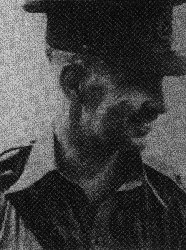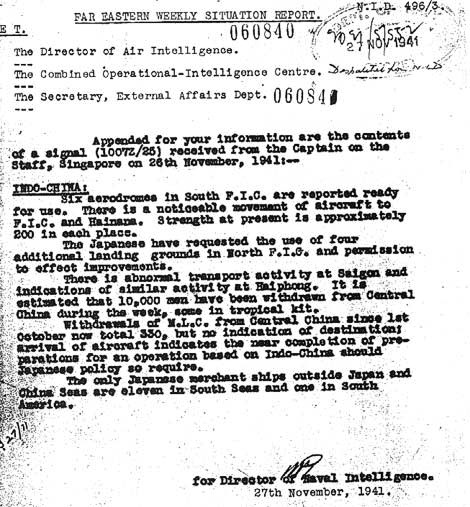|
In 1921 the Committee of Imperial Defence recommended that a British naval base should be built in Singapore. On 16th June that year the cabinet approved plans for it be built on the northern side of Singapore five miles from the Malayan Causeway. The defences would be towards the sea as it was thought the Malayan jungle could not be penetrated by enemy forces. Ten years passed before any further major work was carried out and then disagreement among the armed forces led to compromises, heavy gun batteries were then installed, to protect Singapore from the sea, the air cover would be sorted out later. By 1935 with Germany showing her hand and Japan attacking China, the RAF got their way and airfields were at last built in north Malaya, at Kota Bhara and Kuantan, these were to detect any movement of troops by land or sea, which could cause a problem to Singapore. No agreement was reached between the army and air force as to protect these bases, the distance from Singapore was too great and the terrain caused slow movement of troops, so defending these bases would prove impossible.
Singapore could now be protected from the sea and observation of the north could be carried out, but the 1,000 miles of Malayan coast was unprotected.
In 1937 Major-General W.G.S.Dobbie was asked to look at Malaya’s defences, he reported that during the monsoon season from October to March landings could be made by an enemy on the east coast and bases could be established in Siam. He predicted that landings could be made at Sinora and Patani in Siam, and Kota Bharu in Malaya. He pushed for large reinforcements to be sent immediately. His findings turned out to be correct but they were ignored.
Early in 1939 Britain was more aware of Germany who was expanding its territory and Italy, as Britain thought Japan would attack Russia first. Britain was too complacent about the Far East thinking the world strife would pass it by, how wrong could she be.
 In October 1940 Britain selected Air-Marshal Sir Robert Brooke-Popham as commander-in-chief of the Far East, his job was to unify the forces in defines, but he was given no more resources. Brooke-Popham had been Kenya’s governor so the Far East and its problems were new to him. He saw there was conflict between the forces and tried to make them see the army needed the air force for air cover and the air force needed the army to secure the air fields. He found that out of 336 aircraft only 48 were available, he was promised they would all be available by the end of 1940 but he had his doubts and informed the Chiefs of Staff about the situation. In October 1940 Britain selected Air-Marshal Sir Robert Brooke-Popham as commander-in-chief of the Far East, his job was to unify the forces in defines, but he was given no more resources. Brooke-Popham had been Kenya’s governor so the Far East and its problems were new to him. He saw there was conflict between the forces and tried to make them see the army needed the air force for air cover and the air force needed the army to secure the air fields. He found that out of 336 aircraft only 48 were available, he was promised they would all be available by the end of 1940 but he had his doubts and informed the Chiefs of Staff about the situation.
Lieut.-General Pownall also wrote a report for Churchill about the Singapore Defences, please click here to read it.
Winston Churchill did not feel that expanding the defences of the Far East at the beginning of 1941 was important and wrote to the Chiefs of Staff:
‘The political situation in the Far East does not seem to require, and the strength of the Air Force by no means permits, the maintenance of such large forces in the Far East at this time.’
The Australians sent the 8th Australian Division but their commander Major-General Gordon Bennett later said these were untrained troops.
 Leiutenant-General A.E.Percival was now brought in as G.O.C in March 1941, he had seen action in the first world war as a private soldier and been decorated, he had also served in Malaya as Chief of Staff under Major-General W.G.S.Dobbie, his paper work and general administration was good but his leadership of men had not been put to the test. He found that although the northern airstrips of Malaya had plenty of fuel, they could not be used as the RAF did not have enough air craft or men to occupy or defend them. Also work on defences were not being carried out as the army could not pay the coolie workforce more then the rubber plantations paid as this was said to be unfair competition, so Dobbie’s proposals on defines were not being carried out. IN armed defines he found no tanks in Malaya or Singapore, when this was reported on the 29th September 1941, the feeling was still that Japan would not chance a war with Britain, Holland or the United States and Russia would still be her target. Leiutenant-General A.E.Percival was now brought in as G.O.C in March 1941, he had seen action in the first world war as a private soldier and been decorated, he had also served in Malaya as Chief of Staff under Major-General W.G.S.Dobbie, his paper work and general administration was good but his leadership of men had not been put to the test. He found that although the northern airstrips of Malaya had plenty of fuel, they could not be used as the RAF did not have enough air craft or men to occupy or defend them. Also work on defences were not being carried out as the army could not pay the coolie workforce more then the rubber plantations paid as this was said to be unfair competition, so Dobbie’s proposals on defines were not being carried out. IN armed defines he found no tanks in Malaya or Singapore, when this was reported on the 29th September 1941, the feeling was still that Japan would not chance a war with Britain, Holland or the United States and Russia would still be her target.
Just lately documents released show the British command were well aware of Japanese movements prior to the invasion. Arthur Christie was part of the SOE (Special Operations Executive) group at Tanjong Balai and were sending messages back to Britain warning of the build up of Japanese Troops. Arthur Christie´s son Maurice has some 80 declassified signals sent by his fathers (Sergeant ISSACS wireless operator) group before the attack, this one is dated 27th Nov 1941.
|

|
|
Broadcast by "Izzy" Izzacs one of SOE´s radio men.
|
|
Izzy was later awarded the DCM for his work
|
|
Churchill decided to send the battleship, HMS Prince of Wales, battle cruiser Repulse and an aircraft carrier, Indomitable to the Far East as a deterrent to Japan, but the aircraft carrier had been damaged and could not sail, so the ships sailed with no air cover, this was called Z Force, they arrived at Singapore on 2nd December.
The British front line was devided into three equal sections. The centre section being virgin jungle had no troops. The eastern section was thought to be safe as the roads going south only went a short way into Malaya, it was thought the Japanese would not risk a shore invasion here. The only way to advance south would be to use the good roads in the western section by advancing inland, this was thought impossible.
When the invasion began there was not a single tank in Malaya, the Argyll and Sutherland Highlanders used Rolls-Royce armoured cars, these were used in WW1, 1914-18. These would be facing 230 light and medium Japanese tanks.
A plan against invasion was arranged on the 5th December, code named Matador, it would be put into action as soon as an attack was immanent. The plan was, if an enemy attacked Siam, troops would rush to Singora and defend it against a sea borne attack., this job was given to Major-General Murray-Lyon’s 11th Indian Division who also had to defend Jitra, this over stretched his resources and made it an impossible task. Unknown to Britain this was the day after the Japanese attack convoy had sailed.
|